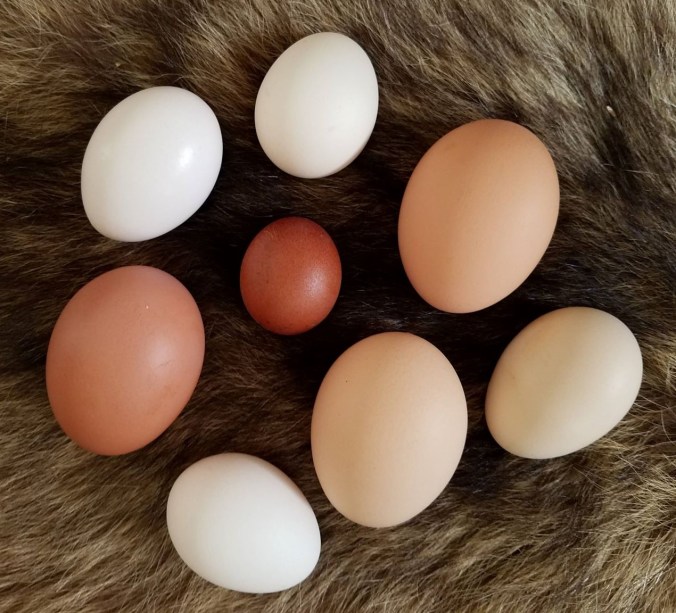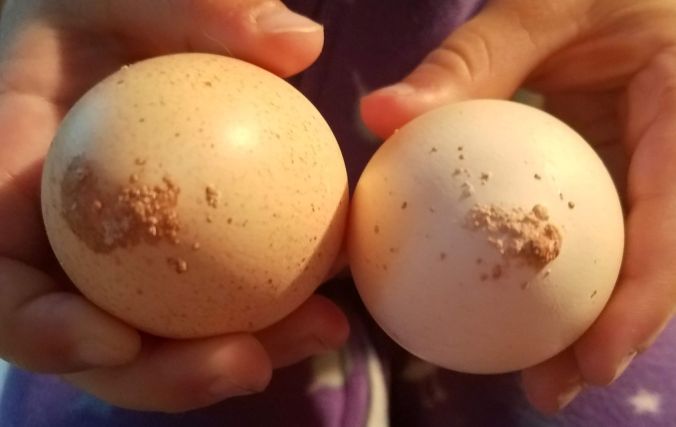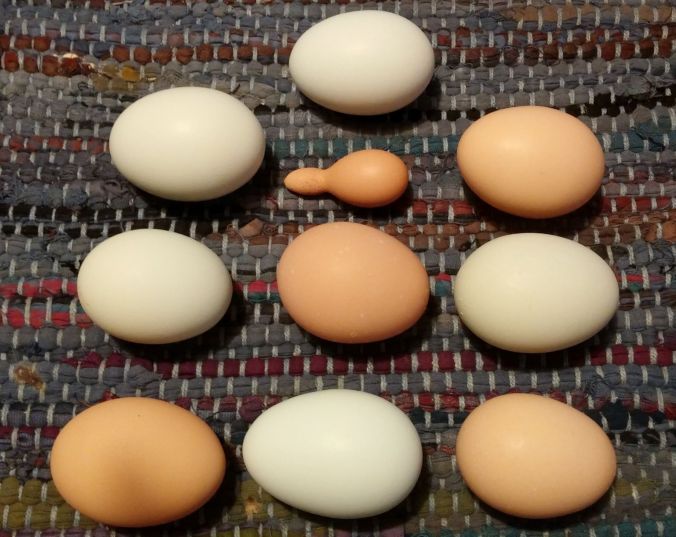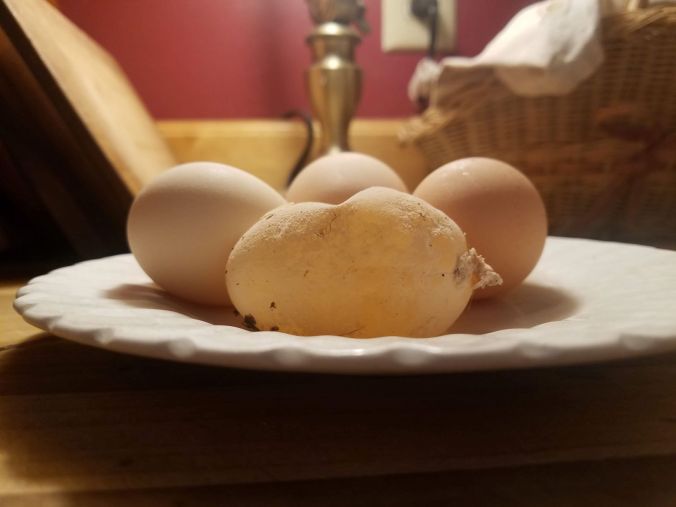Today we’re going to talk about shell production – the industrial-level, incessantly-cranking-‘em-out-level production of … (no, not artillery shells! been listening to a little too much Dan Carlin, have you?) … egg shells!
A little quiz today, or think of it as Some Questions for Fun:
- When is the last time you saw an egg without a shell? Last time you cracked one (or two or three) to make an omelet or some popovers, right? Duh.
Check out these beauties – that orange is what happens when you give your chickens the scraps from a lobster fest.

Okay, clearly you need a harder question, even at this hour.
- Eggs are so beautiful. I sometimes just stare at them. What perfectly beautiful shapes – though you have to think that middle, fattest, section is the hardest moment for the chicken, just sayin’. What lovely variation in color and size my chickens give me:

(Yes, that’s my raccoon skin underneath them, in case you were wondering.)
Speaking of size, they do vary tremendously. Here are some measured next to coins.

And others next to a ruler.

Oh, right, there were questions happening here! Let’s try again.
- What is eggshell made of?
(You science nerds will get this in a second. The rest of us are deeply grateful that there are science nerds in the world to tell us such things.)
The code (is it called a code?), uh, formula? chemical name? is CaCO3, which in English is calcium carbonate. Well, the shell is mostly, as in 95%, calcium carbonate. You always wondered how the shell can be tough enough to protect the growing chick inside it but breakable enough for its 21-day-old beak to poke through. According to Labmate, “The remaining 5% features hundreds of different proteins that affect how calcium carbonate crystallises. It’s this perfectly balanced cocktail that allows mineral crystals and proteins to form an eggshell that’s crack-resistant, then use nanoscale adjustments to change the pliability and let a chick break free when it’s ready to hatch.” Cool.
Fun facts (these from the Exploratorium) also include: a. the eggshell is covered with as many as 17,000 tiny pores that air and moisture can pass through (so the chick can breathe while it’s developing) and b. the shell has a thin outermost coating called the bloom or cuticle that helps keep out bacteria and dust (which is why you don’t need to wash eggs and should use them quickly if you forget this rule).
Question #3!
- What else in nature is like an eggshell (in being made up of calcium carbonate)?
Give it a little thought before you read on…
The examples are striking. Who isn’t impressed with the stalactites and stalagmites you see in caves, like the gigantic ones at Luray Caverns?

Also there’s
- seashells that are the exoskeleton of snails, lobsters, clams (though NOT turtle shells, in case you were wondering – I knew you were wondering)
- coral that you scuba divers find in reefs and the rest of us watch on Blue Planet
- pearls that oysters and clams make, in which the individual CaCO3 crystals “are laid down in such a perfect order that the result is smooth, hard, shiny, and sometimes even iridescent, as in the rainbow colors of abalone shells.” Who knew? (Thank you, again, Labmate.)
- whole mountain chains in the form of chalk, limestone, marble and dolomite. IMA Europe says more than 4% of the earth’s crust is CaCO3, and jrank says 7%, so somewhere between 4-7% is probably right. And you know how much we need chalk (to raise pH in soils with high acidity, clean pewter, keep screws secure and dry your hands for weightlifting, bouldering or gymnastics), limestone (to make steel, cement, fertilizer and even white paper), marble (from columns to countertops, a most gorgeous building material as is) and dolomite (to make glass, bricks and ceramics).Now back to the chicken eggshells.
- What happens when someone in the shell department screws up?
Screws up? What do you mean screws up? Eggs are eggs, right? Smooth on the outside, kinda slimy (when uncooked) on the inside, invaluable in making delicious food and fabulously nutritious.
Nope. Eggs are not just eggs. All eggs are not created equal.
A daydreaming shell maker got a little carried away on these ends – made little warts instead the standard smooth finish because of thinking about his girl maybe (hmmm), or that new car, or those ribs for dinner? Bit too much CaCO3 in those places I’d say. Best have a little chat with this worker about focusing when in production mode. Focus, Jack. We have a job to do here.

The one assigned to this day’s lot was confused. Gourds on his mind perhaps?

This worker forgot (toward the end apparently) what shape we are aiming for in egg production.

Now, back to Question #1. When is the last time you saw an egg without a shell?
Forget the omelet. How’s this? A wildly woobly egg! An intact egg with NO shell to speak of, though maybe a few granules of the calcium carbonate here and there, a spattering you could call it. The bottom flattened out and the top collapsed a bit, but this egg mostly held its shape, its membrane apparently keeping it from gooing all over the place. When we touched it, it squished in like jello. Oh yes, and whoever the shell maker was in this case tried to cover his tracks and squirted a few squirts of the CaCO3 at the end (see that unshapely blob sticking out toward the right?) – undoubtedly a last-ditch effort to demonstrate that it’s not a complete bomb and maybe he should not get fired. Really, HR needs to have a conversation with this employee!

Last question: What’s really going on in the chicken coop???